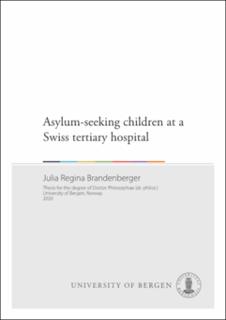| dc.contributor.author | Brandenberger, Julia Regina | |
| dc.date.accessioned | 2020-11-03T12:37:05Z | |
| dc.date.available | 2020-11-03T12:37:05Z | |
| dc.date.issued | 2020-11-11 | |
| dc.date.submitted | 2020-10-31T03:30:29Z | |
| dc.identifier | container/1d/65/12/f2/1d6512f2-7195-4866-bf8b-04d03e19f6a9 | |
| dc.identifier.isbn | 9788230840887 | |
| dc.identifier.isbn | 9788230863916 | |
| dc.identifier.uri | https://hdl.handle.net/1956/24454 | |
| dc.description.abstract | Introduction: As reflected in the Sustainable Development Goal number 3, it is essential that all people have have timely access to health care to ensure healthy lives for everyone at all ages. Although the number of studies investigating the health of migrants is increasing, the field of pediatric migrant health remains underexplored. The general aim of this thesis was therefore to understand the health needs of asylum-seeking children at a Swiss tertiary hospital compared to the local non-asylum-seeking population.
Methods: The three studies presented here are the quantitative part of the project “care for pediatric asylum-seeking children.” They were designed as hospital based retrospective chart reviews, comparing the visits of asylum-seeking pediatric patients with those of nonasylum-seeking pediatric patients. All visits at the hospital from 2016 and 2017 were included. The primary outcome parameters were: the proportion of total visits by the group of asylum-seeking patients compared to the proportion of total visits by non-asylum seeking patients, the main disease that led to admission as defined by the International Classification of Diseases- 10 code, and the proportion of admissions due to ambulatory care sensitive conditions (conditions for which hospital admission can be prevented by early interventions in primary care). Statistical analysis and the generation of graphs were done using Stata.
Results: In total, 1674 visits by 439 asylum-seeking patients and 200,642 visits by 55,350 non-asylum-seeking patients were included. The number of visits by asylum-seeking patients was low 1%) compared to the number of non-asylum-seeking patients (99%). Most visits by asylum-seeking children were by Syrian patients (26%; 442/1674), followed by visits from Eritrean (13%, 210/1674), Afghan (11%, 192/1674), Algerian and Armenian patients (both 11%, 182/1674). The spectrum of disease of asylum-seeking inpatients was comparable to the one of non-asylum-seeking patients with diseases of the respiratory system being the most frequent reason for admission in both groups. They accounted for 17- 19% of admissions in both groups. The proportion of total visits created by frequently visiting patients was higher in the asylum-seeking group with 48% (807/1674) of the total visits in the asylum seeking group versus 25% (49,886/200,642) of the total visits in the non-asylum-seeking group. The amount of potentially preventable hospital admissions was similar in the asylum-seeking (12.1%) and in the non-asylum-seeking (10.9%) patients’
group. Although presenting less frequently to the emergency department than non-asylumseeking patients, the percentage of non-urgent visits at the emergency department by asylum-seeking patients was high with 82.2% (244/297).
Conclusions: In the research context, asylum-seeking patients represent a small and diverse part of the pediatric patient population in the studycontext. The health needs of currently
asylum-seeking patients in the local context are comparable to other children in terms of communicable diseases. The population of asylum-seeking children with very frequent
visits in need of complex care has been neglected so far. Health programs should be tailored to the needs of this particularly vulnerable group. Data of this thesis suggest a relatively
strong primary care system for asylum-seeking patients in the research context, which could serve as good practice example for other regions. Strategies to prevent non-urgent visits at
emergency departments are needed to ensure an efficient use of the health care system. | eng |
| dc.language.iso | eng | eng |
| dc.publisher | The University of Bergen | eng |
| dc.relation.haspart | Paper I: Brandenberger J, Pohl C, Vogt F, Tylleskär T and Ritz N. Health care provided to
asylum-seeking and non-asylum-seeking pediatric patients at a Swiss tertiary hospital. Full text not available in BORA. | eng |
| dc.relation.haspart | Paper II: Gmünder M* and Brandenberger J*, Buser S, Pohl C, Ritz N. Reasons for admission in
asylum-seeking and non-asylum-seeking patients in a paediatric tertiary care centre. Swiss
Med Wkly. 2020;150:w20252. The article is available in the main thesis. The article is also available at: <a href="https://doi.org/10.4414/smw.2020.20252" target="blank">https://doi.org/10.4414/smw.2020.20252</a> | eng |
| dc.relation.haspart | Paper III: Brandenberger J, Bozorgmehr K, Vogt F, Tylleskär T, Ritz N. Preventable admissions
and emergency-department-visits in pediatric asylum-seeking and non-asylum-seeking
patients. Int J Equity Health. 2020 May 1;19(1):58. The article is available in the main thesis. The article is also available at: <a href="https://doi.org/10.1186/s12939-020-01172-w" target="blank">https://doi.org/10.1186/s12939-020-01172-w</a> | eng |
| dc.rights | Attribution-NoDerivs (CC BY-ND). This item's Creative Commons-license does not apply to the included articles in the thesis. | eng |
| dc.rights.uri | https://creativecommons.org/licenses/by-nd/4.0/ | eng |
| dc.title | Asylum-seeking children at a Swiss tertiary hospital | eng |
| dc.type | Doctoral thesis | eng |
| dc.date.updated | 2020-10-31T03:30:29Z | |
| dc.rights.holder | Copyright the Author. | eng |
| dc.contributor.orcid | 0000-0001-7169-8184 | |
| dc.description.degree | Doktorgradsavhandling | |
| fs.unitcode | 13-26-0 | |

